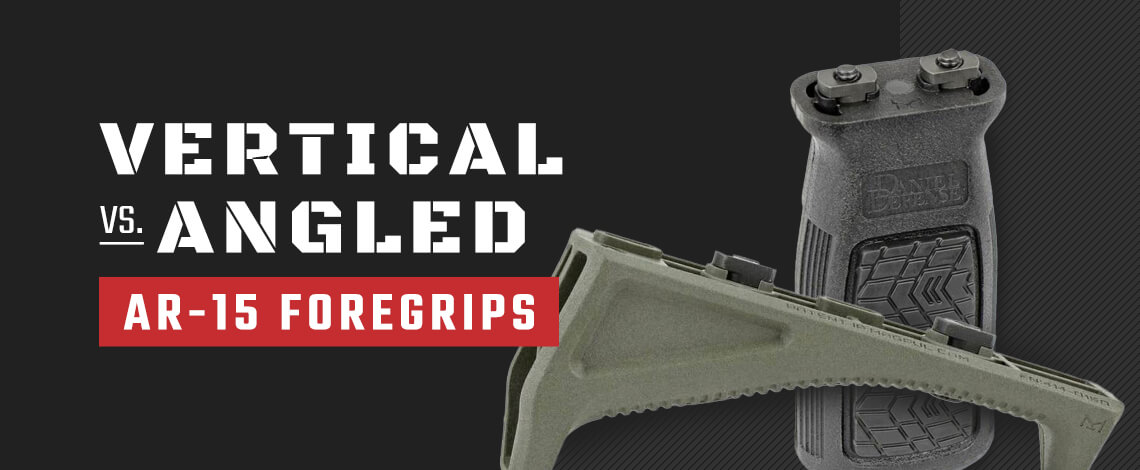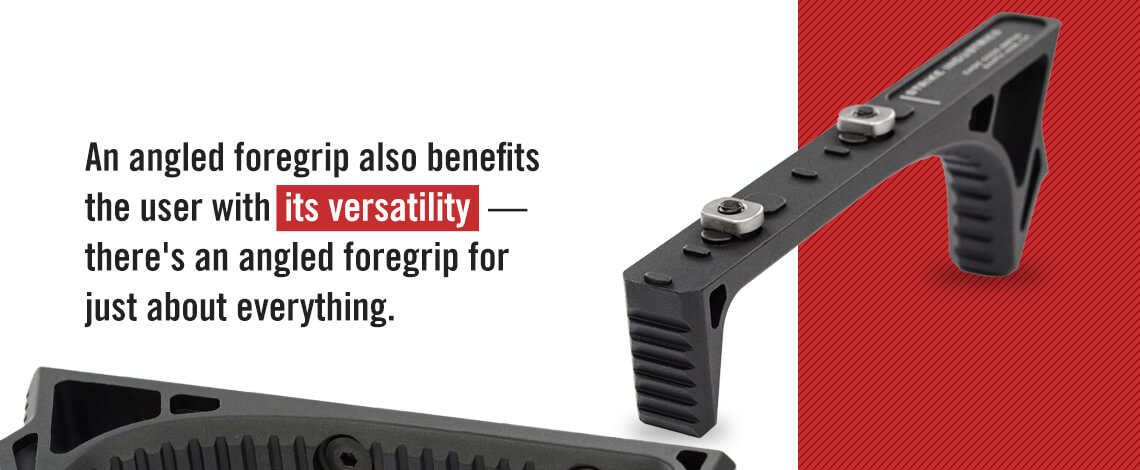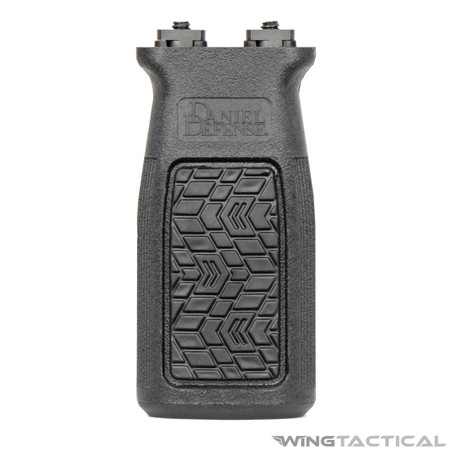
From scopes to barrels to stocks and foregrips, every piece of hardware you put on your rifle is critical when it comes to your overall shooting experience.
Of course, the needs of every shooter are different, so there is no right or wrong way to customize your rifle. The most important thing is what feels best in your hands. When it comes to choosing what kind of foregrip to put on your rifle, there are two types you can use: vertical foregrips and angled foregrips.
Not sure which one is best for you? Don’t sweat it. Here’s a little primer on each type of grip.
Vertical Foregrips
Some shooters find it easier to grip at a vertical angle instead of a horizontal one. As such, vertical foregrips are grips that extend straight down from the barrel at a 90-degree angle from your firearm's handguard – some shooters even refer to them as “broomstick” grips. When you put one of these grips on your rifle, you gain more control over your weapon with your off-trigger hand.
These grips maintain pressure on the handguard, making it easier to handle any directional recoil and keep the muzzle on target for quick follow-up shots. They are also compatible with a “C” clamp grip style for optimal control.
You can attach a vertical foregrip to an AR-15 or other military-style rifle with a forend quad rail. Many vertical foregrips are also compatible with other attachment systems like KeyMod cutouts.
Pros and Cons of Vertical Foregrips
Vertical foregrips are perhaps best-suited to shooters on the range who need maximum vertical stability, as well as shooters firing large quantities of rounds quickly. In situations where you fire more than one hundred rounds, the barrel and rail become extremely hot, making them nearly impossible to touch without wearing gloves. Vertical foregrips are great for this purpose, as their distance from the barrel and rail cause them to absorb less heat, keeping you focused on your target.
Vertical grips also won't exhaust your chest and shoulder muscles as quickly as angled grips thanks to their off-hand grasp. This unique grip style is especially suited to long shooting sessions or patrols when resting your muscles is particularly important. What's more, the off-hand helps you mitigate recoil for greater speed and accuracy.
While this is one great advantage of vertical foregrips, it is also important to remember that they do have the potential to latch onto your gear, so it’s critical to watch your form and consider every movement when using this type of grip. Some fan-favorite vertical foregrips minimize this concern by using an adjustable design, allowing you to quickly transform them into an angled profile. Certain models even fold down completely, allowing for easier storage.
Pictured Above: Daniel Defense Enhanced M-LOK Vertical Foregrip
With seven distinct positions to choose from, this AR-15 vertical foregrip gives you the options you need to ensure maximum accuracy. You’ll be able to hold your rifle comfortably and steadily no matter your current situation.
Angled Foregrips
Angled foregrips are becoming increasingly popular. While some shooters think of them as a newer option, they are actually one of the oldest. The angled foregrip first made its appearance about 100 years ago on the original Thompson submachine gun.
Today's angled foregrips are ergonomically designed with human physiology in mind. They give you strong control of your grip in what many find to be a more comfortable, natural position. Shooters who prefer angled foregrips often state that these kinds of grips allow you to aim precisely with much less tension.
Angled foregrips provide surface contact that's less than 90 degrees, placing the user's hand more in line with the rifle bore for smoother positioning. To use an angled foregrip, the user wraps their hand around the grip and pulls the rifle straight back into their shoulder.
Pros and Cons of Angled Foregrips
Many riflemen prefer the angled foregrip for its enhanced control provided in rapid fire situations. By placing your hand closer to the rail of the rifle, your form is drawn more firmly into your shoulder, and tension in the hands is reduced. This helps combat muzzle climb, which allows for greater precision over a series of rounds.
Because this grip leads to a strong, consistent form, you’ll enjoy more fluid lateral movement and a more instinctive shooting posture, making the transition from target to target faster and more precise.
The angled foregrip also provides you with a reference point, which can help you achieve a more consistent form than simply gripping the rail alone. By using the grip as a reference point, you’ll place your hand in the same spot every time you grip the rifle, which can help increase accuracy over time.
An angled foregrip has a cleaner profile than vertical foregrips, making it less likely to hang on brush or gear. What's more, angled foregrips prevent the listing that happens when you hold a vertical foregrip improperly.
Whereas the vertical grip juts out from one spot on the handguard, some angled grips take up more space. With this in mind, consider the amount of available rail space before deciding on an angled foregrip.

An angled foregrip also benefits the user with its versatility — there's an angled foregrip for just about everything. Angled grips give you the control of a grip with the traction of a hand stop. You can even find angled foregrips with built-in heat shielding for your off-hand. Many angled foregrips also have barrier stops that allow you to transition seamlessly from movement to cover.
Regardless of which model you choose, most shooters find that they get the best performance when they mount the angled foregrip as far forward on the rail as possible.
Pictured Above: Strike Industries LINK Curved Foregrip
Available in multiple colors, this lightweight grip allows you to aim your weapon with less tension, providing more accuracy.
Another Popular Choice: Fortis Shift Short Angled Grip
This angled foregrip can be used as a rest for your three fingers or a hand stop or reference point for the thumb-over-bore method.
Personal Preference
Every shooter has different requirements for his or her rifles. When it comes to choosing the type of grip that’s right for you, you’ll probably want to try both types to see what feels most natural in your hands. Whether you choose a vertical foregrip, an angled foregrip, or no grip at all, what’s most important is your accuracy, performance and comfort – so explore a few different options and stick with what works best for you.
Have you tried vertical and angled foregrips? Which do you prefer? Let us know in the comments below!

